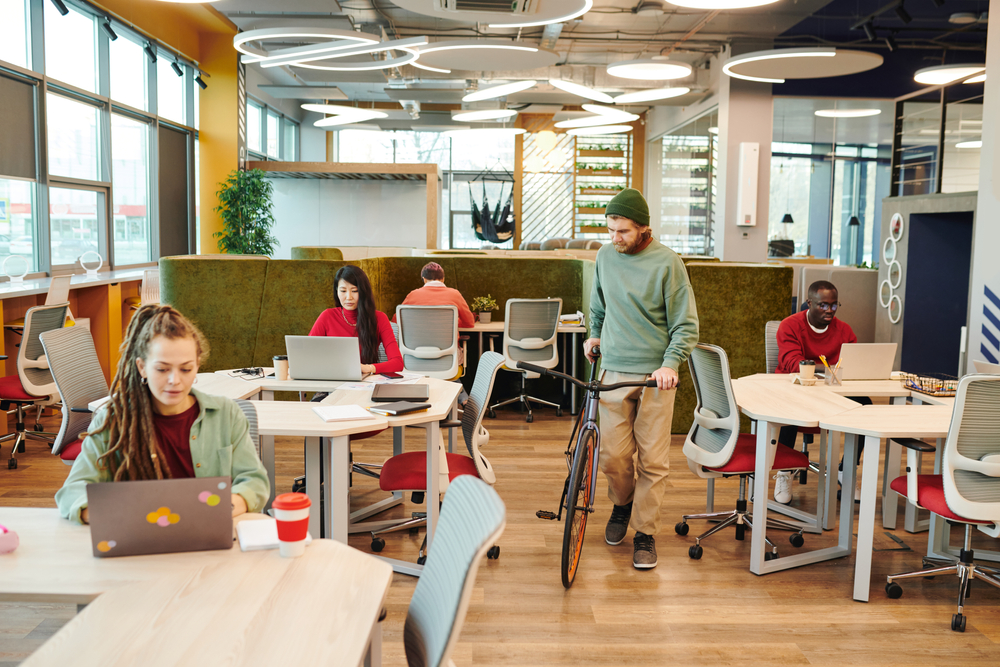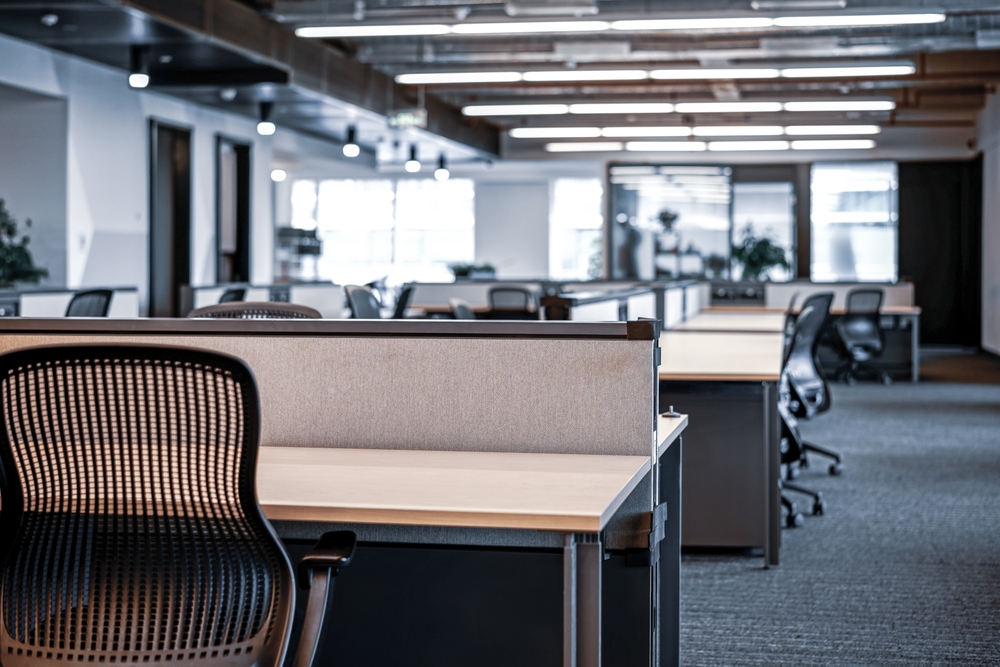
What is office hoteling? And is it similar to hot desking?
In the evolving landscape of modern work environments, office hoteling and hot desking have emerged as popular strategies aimed at maximizing efficiency and flexibility within workplaces. These approaches cater to the needs of dynamic business operations and the growing demand for adaptable workspaces.
In this story
Definition of Office Hoteling
Office hoteling refers to a workspace management system where employees reserve desks or workstations in advance, similar to booking a hotel room. This system is designed to optimize the use of office space by allowing employees to book their preferred workspace based on availability and their specific work requirements. Office hoteling typically relies on technology platforms that enable employees to see available spaces, make reservations, and manage their bookings seamlessly. This approach is particularly beneficial for organizations with a significant number of remote or traveling employees, as it ensures that office resources are used efficiently and reduces the need for dedicated desks for each employee.
Overview of Hot Desking
Hot desking, on the other hand, is a more fluid arrangement where employees can choose from available desks on a first-come, first-served basis, without prior reservation. This approach encourages flexibility and spontaneity, as employees select their workstations each day based on personal preference or immediate project needs. Hot desking is designed to foster collaboration and interaction among team members by allowing them to sit next to different colleagues each day, thereby breaking down silos and encouraging the exchange of ideas. It also leads to better space utilization by accommodating fluctuating numbers of employees in the office, especially in organizations with a high degree of remote work.
Purpose of Flexible Workspaces
The purpose of flexible workspaces, including office hoteling and hot desking, is to create an adaptable and efficient office environment that meets the diverse needs of modern employees. These systems are responses to the changing nature of work, where mobility, remote work, and project-based collaboration require more dynamic office solutions. Flexible workspaces aim to enhance productivity by providing employees with the ability to choose their work environment based on their tasks, preferences, and collaboration needs. Furthermore, these models can lead to cost savings for organizations by reducing the need for extensive real estate and fixed office setups. By implementing flexible workspace strategies, companies can create a more agile and responsive work environment that aligns with contemporary business practices and employee expectations.
In conclusion, office hoteling and hot desking are innovative approaches that reflect the shift toward more flexible and efficient workspace management. By understanding these concepts, organizations can better adapt to the demands of modern work and create environments that support both individual productivity and collective collaboration.
Understanding Office Hoteling

Office hoteling represents a transformative approach to workspace management that aligns with the evolving needs of modern businesses. By allowing employees to reserve workspaces as needed, this system enhances flexibility and efficiency within the office environment.
How Office Hoteling Works
Office hoteling operates on a reservation-based system, much like booking a hotel room. Employees are not assigned permanent desks; instead, they reserve workstations in advance for the times and dates they plan to be in the office. This reservation can be made through an online platform or mobile app, where employees can view available spaces and select a desk that best suits their needs for that particular day or task. The physical office space is typically organized into various zones or types of workstations, such as quiet areas, collaborative spaces, or ergonomic desks, allowing employees to choose based on their work requirements. This system is particularly beneficial for companies with a large number of remote or mobile workers, as it ensures that office space is used efficiently without the need for permanent desk allocation.
Technology and Systems Involved
The implementation of office hoteling relies heavily on technology to facilitate seamless booking and management of workspaces. Key technological components include reservation systems, often integrated with the company’s existing IT infrastructure, to provide real-time availability and booking capabilities. These systems may be equipped with features such as interactive floor plans, calendar integrations, and user profiles, enhancing the user experience and ensuring efficient space utilization. Additionally, IoT (Internet of Things) technology can be employed to monitor occupancy and optimize environmental conditions, such as lighting and temperature, based on real-time data. This technological backbone not only streamlines the booking process but also provides valuable insights into space utilization patterns, which can inform future office design and resource allocation.
Benefits of Office Hoteling
Office hoteling offers a range of benefits that contribute to improved organizational efficiency and employee satisfaction. One of the primary advantages is the optimization of office space, reducing the need for unused or underutilized workstations and potentially lowering real estate costs. This space efficiency is particularly valuable in urban settings where office space is at a premium. Additionally, office hoteling supports greater flexibility for employees, allowing them to choose workstations that align with their immediate needs, thereby enhancing productivity and job satisfaction. The ability to select different work environments based on task requirements can also foster creativity and collaboration among employees, as they interact with diverse colleagues and teams.
Furthermore, the data collected through office hoteling systems can provide organizations with insights into workspace usage and employee preferences, enabling more informed decisions about office design and resource allocation. By adopting office hoteling, companies can create a more dynamic and adaptive work environment that meets the needs of a modern, flexible workforce, ultimately driving organizational success and employee engagement.
Understanding Hot Desking

As organizations strive to create more flexible and dynamic work environments, hot desking has emerged as a popular model that fosters adaptability and collaboration. By allowing employees to choose their workspaces on a daily basis, hot desking supports a fluid and interactive office culture.
How Hot Desking Works
Hot desking is a workspace arrangement where employees do not have assigned desks. Instead, they select from available workstations on a first-come, first-served basis each day. This model eliminates the concept of personal workspaces, encouraging employees to move around the office and utilize different areas according to their needs. Upon arriving at the office, employees choose any open desk, set up their work for the day, and pack up their belongings at the end of their shift. This system requires minimal technological infrastructure compared to office hoteling, as it does not involve advance reservations or complex booking systems. However, it often includes features like storage lockers for personal items and access to shared resources such as printers and meeting rooms.
Key Features of Hot Desking
The key features of hot desking include its emphasis on flexibility and spontaneity. Unlike office hoteling, which involves pre-planning, hot desking thrives on real-time decision-making by employees, allowing them to adapt their workspace choices to immediate needs. This model fosters an environment of constant change and interaction, as employees can choose to sit near different colleagues daily, promoting cross-departmental communication and collaboration. Additionally, hot desking spaces are typically designed to be versatile and multifunctional, with various types of workstations available to accommodate different tasks, from quiet zones for focused work to open areas for group discussions.
Benefits of Hot Desking
Hot desking offers numerous benefits that contribute to a more agile and efficient workplace. One of the primary advantages is the efficient use of office space, which can lead to cost savings for organizations. By eliminating fixed desks, companies can accommodate more employees within the same footprint, reducing the need for excess real estate. This is particularly advantageous in high-cost urban areas where space is at a premium. Additionally, hot desking encourages a culture of flexibility and adaptability, as employees are not tied to a specific location and can adjust their work environment to suit their tasks and preferences.
Moreover, the dynamic nature of hot desking promotes increased interaction and collaboration among employees. By sitting with different colleagues each day, employees have the opportunity to share ideas, knowledge, and experiences, fostering innovation and creativity. This model also supports a more egalitarian work culture, as the absence of assigned desks reduces hierarchical barriers and encourages open communication across all levels of the organization.
In conclusion, hot desking is a versatile and effective workplace strategy that enhances flexibility, collaboration, and efficiency. By understanding its workings and benefits, organizations can create a dynamic and inclusive work environment that meets the needs of a modern, mobile workforce.
Comparison Between Office Hoteling and Hot Desking

In the quest for more flexible and efficient workspace solutions, both office hoteling and hot desking have gained popularity as modern approaches for managing office environments. While they share several similarities, each model also possesses distinct characteristics that make them suitable for different organizational needs.
Similarities Between the Two Models
Office hoteling and hot desking both aim to optimize the use of office space by eliminating the need for permanent desks and encouraging more dynamic use of work environments. Both models promote flexibility, allowing employees to choose workstations based on their immediate needs and preferences rather than being tethered to a single location. This flexibility supports remote work and mobile employees by providing a variety of workspace options that can be easily accessed when visiting the office. Additionally, both approaches encourage interaction and collaboration among employees by enabling them to sit near different colleagues, fostering a culture of communication and innovation.
Differences and Unique Features
Despite their similarities, office hoteling and hot desking differ in their implementation and operational nuances. Office hoteling requires employees to reserve workspaces in advance, often using an online platform or app. This reservation system allows for more structured planning and can be particularly beneficial for organizations that need to manage space usage carefully due to fluctuating employee presence. The advance booking feature ensures that employees can secure a workspace that meets their specific needs, such as proximity to certain teams or access to particular equipment.
In contrast, hot desking operates on a first-come, first-served basis, with no prior reservations needed. This real-time choice allows for greater spontaneity and can accommodate last-minute changes in employee schedules. However, it may also lead to uncertainty regarding workspace availability during peak times. Hot desking spaces are typically designed to be highly adaptable, accommodating various work styles and preferences.
Use Cases for Each Approach
The choice between office hoteling and hot desking depends on an organization’s specific needs and work culture. Office hoteling is well-suited for companies with a significant number of remote or traveling employees, where predictable patterns of office attendance allow for efficient space management. It is also ideal for organizations that require employees to work closely with specific teams or departments, as reservations can be made to facilitate these collaborations.
Hot desking, on the other hand, is more appropriate for organizations that prioritize flexibility and spontaneity. It works well in environments where employees frequently shift between projects or teams, as it encourages cross-departmental interactions and collaboration. Additionally, hot desking is suitable for creative industries or startups where a flat organizational structure and open communication are essential to the company culture.
In conclusion, while office hoteling and hot desking share the goal of maximizing workspace efficiency and flexibility, their unique features and implementation make them suitable for different organizational contexts. By understanding these distinctions, companies can choose the approach that best aligns with their operational needs and cultural values.
Challenges and Considerations
Transitioning to office hoteling or hot desking can bring about significant benefits in terms of flexibility and space optimization, but these models also come with their own set of challenges and considerations that organizations must address to implement them successfully.
Potential Drawbacks
One of the primary drawbacks of both office hoteling and hot desking is the potential for reduced personal space and a sense of instability among employees. Without dedicated desks, employees may feel a lack of ownership over their work environment, which can impact comfort and productivity. Additionally, the need to set up and pack up workstations daily can be seen as an inconvenience, potentially leading to inefficiencies. The lack of permanent seating arrangements may also result in challenges with equipment availability, such as monitors or ergonomic chairs, which can affect employees who have specific workplace needs or preferences.
Employee Adaptation and Acceptance
Adapting to a flexible workspace model requires a cultural shift that may not be immediately embraced by all employees. Resistance can stem from discomfort with change, concerns about privacy, or anxiety over the availability of preferred workspaces. Effective communication is crucial in easing this transition. Organizations should engage employees early in the process, providing clear explanations of the benefits and addressing concerns proactively. Offering training sessions or workshops can help employees become familiar with the new systems and technologies involved in reserving spaces or managing their workstations. Involving employees in the design and implementation stages can also foster a sense of ownership and acceptance, as their feedback can shape the workspace to better meet their needs.
Implementing Flexible Workspaces Successfully
Successful implementation of office hoteling or hot desking requires careful planning and a focus on creating a supportive environment for all employees. Organizations should invest in reliable technology systems that facilitate seamless booking and management of workspaces, ensuring that these tools are user-friendly and accessible. Additionally, maintaining a variety of workspace options is essential to accommodate different work styles and task requirements, from quiet zones for focused work to collaborative areas for team projects.
Regular feedback loops are vital for continuous improvement, allowing organizations to adjust their approach based on employee experiences and needs. This iterative process ensures that the flexible workspace model remains aligned with organizational goals and employee expectations. It’s also important to balance flexibility with some level of structure, such as designated zones or guidelines for specific types of work, to prevent chaos and maintain productivity.
In conclusion, while office hoteling and hot desking offer significant advantages, their successful implementation requires addressing potential drawbacks, facilitating employee adaptation, and maintaining flexibility with structure. By considering these elements, organizations can create a dynamic and efficient work environment that meets the needs of a modern workforce.
Conclusion: Recap of Key Points and Future Trends in Workspace Management
As organizations continue to evolve in response to the demands of a dynamic business environment, the concepts of office hoteling and hot desking have emerged as innovative solutions for managing workspace efficiently. These models, while distinct in their implementation, share a common goal of maximizing flexibility and optimizing space utilization to meet the needs of a modern workforce.
Office hoteling and hot desking both offer advantages in terms of reducing real estate costs and providing employees with the flexibility to choose their work environment. Office hoteling operates on a reservation system, allowing employees to book specific workstations in advance, which ensures predictability and organization. In contrast, hot desking offers a more spontaneous approach, with employees selecting available desks on a first-come, first-served basis, fostering a dynamic and collaborative atmosphere. Despite these differences, both models emphasize the importance of adaptability and encourage interaction among employees, contributing to a more agile and responsive work culture.
However, transitioning to these flexible workspace models also presents challenges that organizations must address, such as potential drawbacks related to employee comfort and the need for effective communication to facilitate adaptation. Successfully implementing these approaches requires a thoughtful balance of structure and flexibility, supported by reliable technology and ongoing feedback from employees.
Looking ahead, the future of workspace management is set to be shaped by several emerging trends that build on the principles of office hoteling and hot desking. As remote work becomes increasingly prevalent, hybrid models that combine in-office and remote work will likely become the norm. This shift will emphasize the need for flexible office arrangements that can accommodate varying levels of employee presence and ensure that space is used efficiently.
Technology will continue to play a pivotal role in the evolution of workspace management. Advancements in artificial intelligence and data analytics will enable organizations to gain deeper insights into space utilization and employee preferences, allowing for more personalized and efficient workspace configurations. Moreover, the integration of smart technologies, such as IoT devices and automated systems, will enhance the functionality and adaptability of work environments.
Sustainability will also become a central consideration in workspace management, as organizations strive to reduce their environmental footprint. This may involve designing spaces that support energy efficiency, waste reduction, and sustainable practices, aligning with broader corporate social responsibility goals.
In conclusion, office hoteling and hot desking provide valuable frameworks for navigating the complexities of modern workspace management. By embracing these models and adapting to future trends, organizations can create flexible, efficient, and sustainable work environments that meet the diverse needs of their employees and drive long-term success.




Leave a Reply